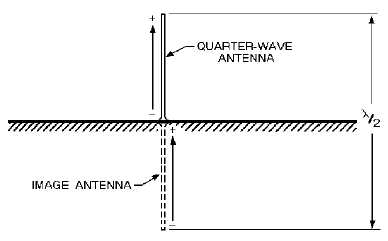4-22
Figure 4-17.—Mobile antennas.
As stated above, a grounded quarter-wave antenna will resonate at the same frequency as an
ungrounded half-wave antenna. This is because ground has high conductivity and acts as an electrical
mirror image. This characteristic provides the missing half of the antenna, as shown in the bottom part of
figure 4-18. In other words, the grounded quarter-wave antenna acts as if another quarter-wave were
actually down in the earth.
Figure 4-18.—Grounded quarter-wave antenna image.
Characteristics of Quarter-Wave Antennas
The grounded end of the quarter-wave antenna has a low input impedance and has low voltage and
high current at the input end, as shown in figure 4-18. The ungrounded end has a high impedance, which
causes high voltage and low current. The directional characteristics of a grounded quarter-wave antenna
are the same as those of a half-wave antenna in free space.
As explained earlier, ground losses affect radiation patterns and cause high signal losses for some
frequencies. Such losses may be greatly reduced if a perfectly conducting ground is provided in the





